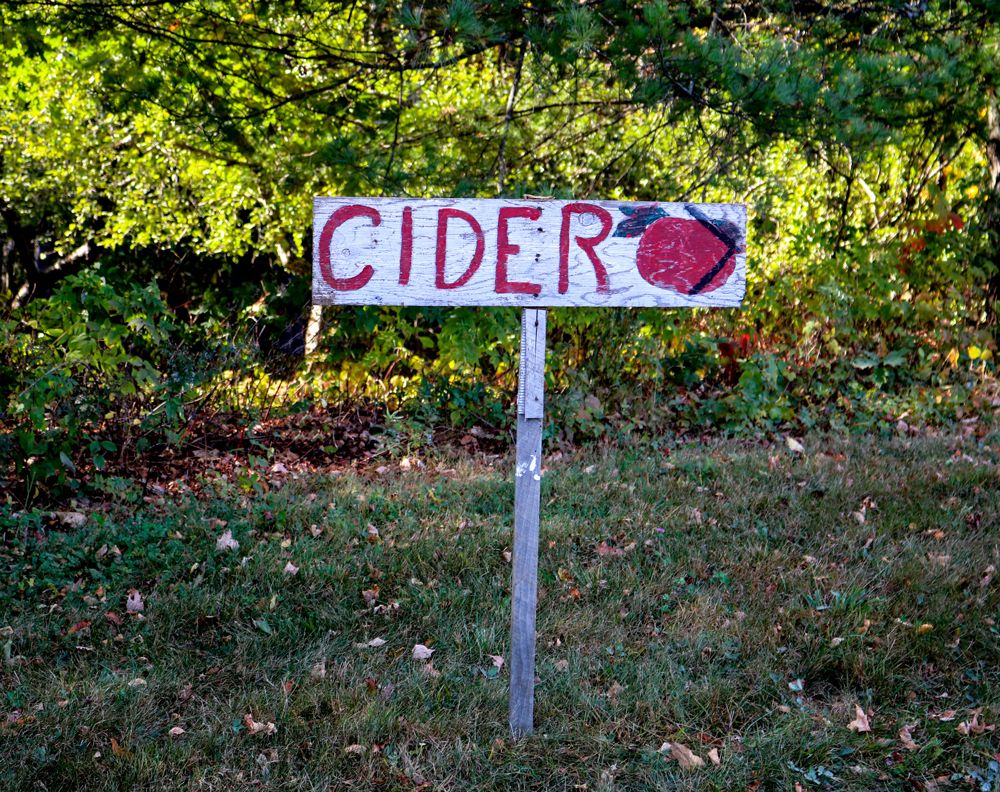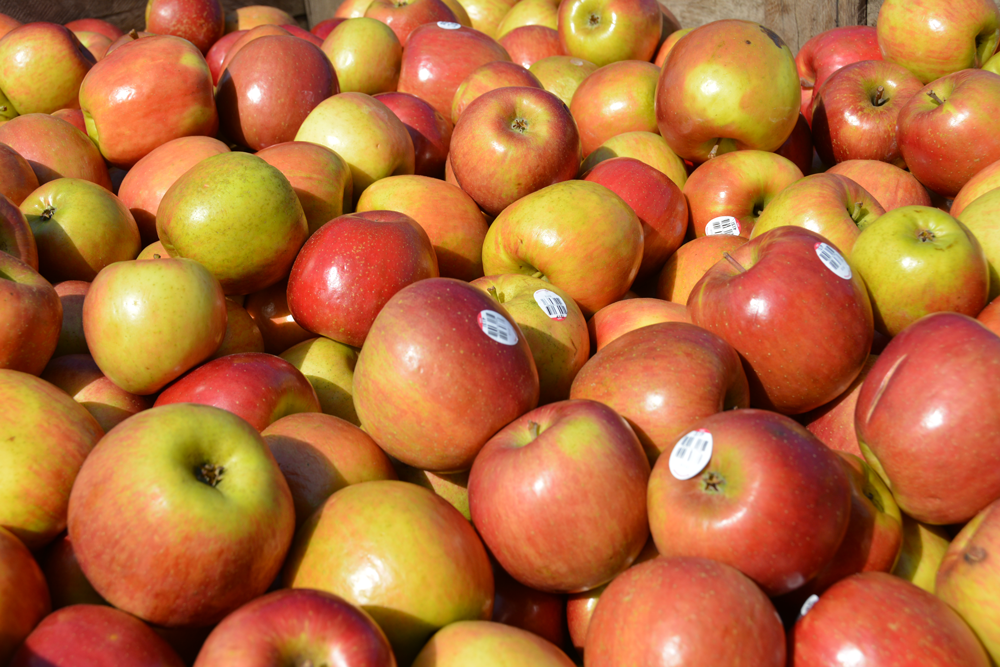By Michael Dwyer | Photography by Michael Dwyer
As if under a spell, Michiganders from all over join with family and friends for a pilgrimage to the cider mill. Sweet cider, warm doughnuts and fresh produce take center stage with caramel apples, old-fashioned candy and home-baked pies as the supporting cast. In addition, many farms have added corn mazes, pony rides and U-picks to entertain and delight all ages. Watching cider being made often is the main attraction.
Keeping to tradition, many mills still press cider as it was done a century ago in the style of and using the materials (wood and steel) available at that time. “We feel that the oak press gives our cider a more distinct flavor,” said Nancy Steinhauer of the Dexter Cider Mill. Its cider never touches plastic until it’s jugged.
 Located in downtown Dexter along the Huron River, this historic mill has been continuously making cider since 1886. Years ago, the leftover apple mash (seeds, stems and skin) was dumped in the river. Of course, that doesn’t happen today. “Now the mash is hauled away,” Steinhauer said.
Located in downtown Dexter along the Huron River, this historic mill has been continuously making cider since 1886. Years ago, the leftover apple mash (seeds, stems and skin) was dumped in the river. Of course, that doesn’t happen today. “Now the mash is hauled away,” Steinhauer said.
When it comes to treating the cider, by state law, mills that wish to sell wholesale must pasteurize or use ultraviolet light to treat their product. “We feel that unpasteurized cider is better tasting,” Steinhauer said. While pasteurized cider has a longer shelf life, many aficionados will travel far and wide to stock up on nontreated cider.
 “We have amazing customers, too. It’s a place that people want to come to, and we feel very fortunate,” she added. Nancy’s parents bought the cider mill in 1986 and are only the third family to own it. They originally purchased it as “a retirement project,” and it continues to be just that for Nancy and her husband Marty. “The mill is still fun to me,” she said. “We are looking forward to many more years.”
“We have amazing customers, too. It’s a place that people want to come to, and we feel very fortunate,” she added. Nancy’s parents bought the cider mill in 1986 and are only the third family to own it. They originally purchased it as “a retirement project,” and it continues to be just that for Nancy and her husband Marty. “The mill is still fun to me,” she said. “We are looking forward to many more years.”
Water powered like magic
Cider mills, gristmills and sawmills were once more commonly powered by water. Using the fast flow of a nearby river or creek, the water would be diverted to a wheel or turbine to power the press. That method went out of style when electricity became available in the mid-20th century. The iconic Franklin Cider Mill in Bloomfield Hills switched from water to electric power in 1968 when an accident took out the water wheel. Today, two Michigan cider mills still use water to power their cider presses: Parshallville and Yates.

Parshallville Cider Mill, located on the North Ore Creek in Fenton, started as a gristmill in 1869 and now makes cider every autumn with waterpower.
Yates Cider Mill, owned by Mike and Katie Titus in Rochester Hills, also remains water powered by the Clinton River. Yates started as a sawmill in 1863, moved to pressing cider in 1876 and uses the same underground turbine that was installed in 1894.
“The turbine was purchased from the James Leffel Company in Springfield, Ohio,” Mike Titus said. “Since the turbine is not visible (it is underwater in the mill flume), Katie’s grandpa, Charles Posey, installed the exterior water wheel so that people could see the water from the millrace turning a water wheel. It has since become part of the iconic image of the mill. The underwater turbine always has provided waterpower for the pressing operation.”

“The Clinton River provides the lifeblood for the operation of the mill,” Mike continued. “Maybe just as important, the river contributes to an atmosphere that makes Yates such a unique property to visit. It’s a place to relax and take in what I think is one of the most beautiful settings in southeast Michigan. The river meanders through parks on both sides of Yates’ property and offers recreational activities like kayaking, fishing, swimming or just relaxing on a log on the river’s edge.”
Visiting a cider mill can overwhelm a person’s senses. For one thing, just the aromas of the bakery alone are enticing. “The sights and sounds from the press making cider bring back memories for people,” Mike said. “Of course, the feel and taste of a warm doughnut in your mouth followed by some cold or hot cider is part of something that has been a tradition for generations.”

The core of the charm
An average of 25 million bushels of apples are picked each year in Michigan, the nation’s third-largest producer. Half of all those are gobbled up as fresh fall treats, and the rest are turned into desserts, sauce and cider.
Pure Michigan apple cider is 100% natural with no added sugar, plus it’s fat-free, sodium-free, cholesterol-free and gluten-free. Dozens of varieties — red, green and yellow — are grown commercially in the state, and nationally, there are upward of 2,500 types across the United States.
 “Not all of our 35 varieties are used for cider making; some are better than others for eating fresh,” said John Robinette, co-owner of Robinette’s Orchard in Grand Rapids. “After Labor Day, more varieties become available for cider making with the bulk of our crop being harvested in October. Therefore, our cider is always evolving as the season progresses, meaning you will never get the same-tasting gallon from one week to the next.
“Not all of our 35 varieties are used for cider making; some are better than others for eating fresh,” said John Robinette, co-owner of Robinette’s Orchard in Grand Rapids. “After Labor Day, more varieties become available for cider making with the bulk of our crop being harvested in October. Therefore, our cider is always evolving as the season progresses, meaning you will never get the same-tasting gallon from one week to the next.
“When we do get more varieties, each batch of cider will usually contain up to five different types. When I’m making cider, my favorite varieties to use are Northern Spy, McIntosh, Jonathon and Golden Delicious. If you found all these in the same batch, you are sure to have a delicious cider.”
His is one of the few cider mills that is open all year long. Robinette said the mill makes 600 to 700 gallons in the fall and freezes it for sale over the summer. “The frozen cider, once thawed, tastes just as good as fresh and should last two weeks in your refrigerator,” Robinette said. ≈

Michigan apple facts
Michigan is the third-largest apple producer in the U.S.
Half of all apples are sold as fresh, ready to eat
An average of 25.2 million bushels of apples are harvested each year
There are 11.3 million apple trees in commercial production, on 825 family-run farms, on 35,500 acres
The crabapple is the only native apple to North America
There are 2,500 varieties of apple in the U.S. and 7,500 varieties of apple worldwide
Apples grow in all 50 states
Johnny Appleseed’s real name was John Chapman
Michigan’s state flower is the apple blossom
Apples are part of the Rose family of plants
One bushel of apples will make about 3 gallons of cider

Cider speak
Cider – also called apple cider, sweet cider, soft cider — the untreated juice from fresh-pressed apples
Mulled Cider – hot apple cider with a combination of spices including cinnamon, nutmeg, cloves and others
Cider Mill – the equipment used to crush and press apples into cider; the location of the business, part of a farm or a stand-alone business
Mash – all the bits, including the stems, seeds and skin, that are left over after all the juice has been pressed from the apples
Pasteurization – a process to treat milk or fruit juice with heat to eliminate bacteria and pathogens, and to extend shelf life
Ultraviolet irradiation – a treatment alternative to pasteurization that uses a short wavelength ultraviolet light to eliminate bacteria and pathogens
Bakery – commonly found at cider mills where ovens are used to bake pies, fry doughnuts and make desserts to sell
Donut – also doughnut – a cake mix batter fried in oil and often covered in cinnamon and sugar — a staple bakery item at most cider mills
Water power – using a water source to generate power from wheels and turbines, and controlled with gears, belts and levers
Water turbine/water wheel –
a rotary machine that converts gravity-fed water into mechanical energy
Cold storage – a method to hold and preserve apples by controlling the temperature, humidity and oxygen levels.
Michael Dwyer is an awarding-winning broadcast journalist turned writer who lives in Rochester. – Michigan BLUE Magazine








Facebook Comments